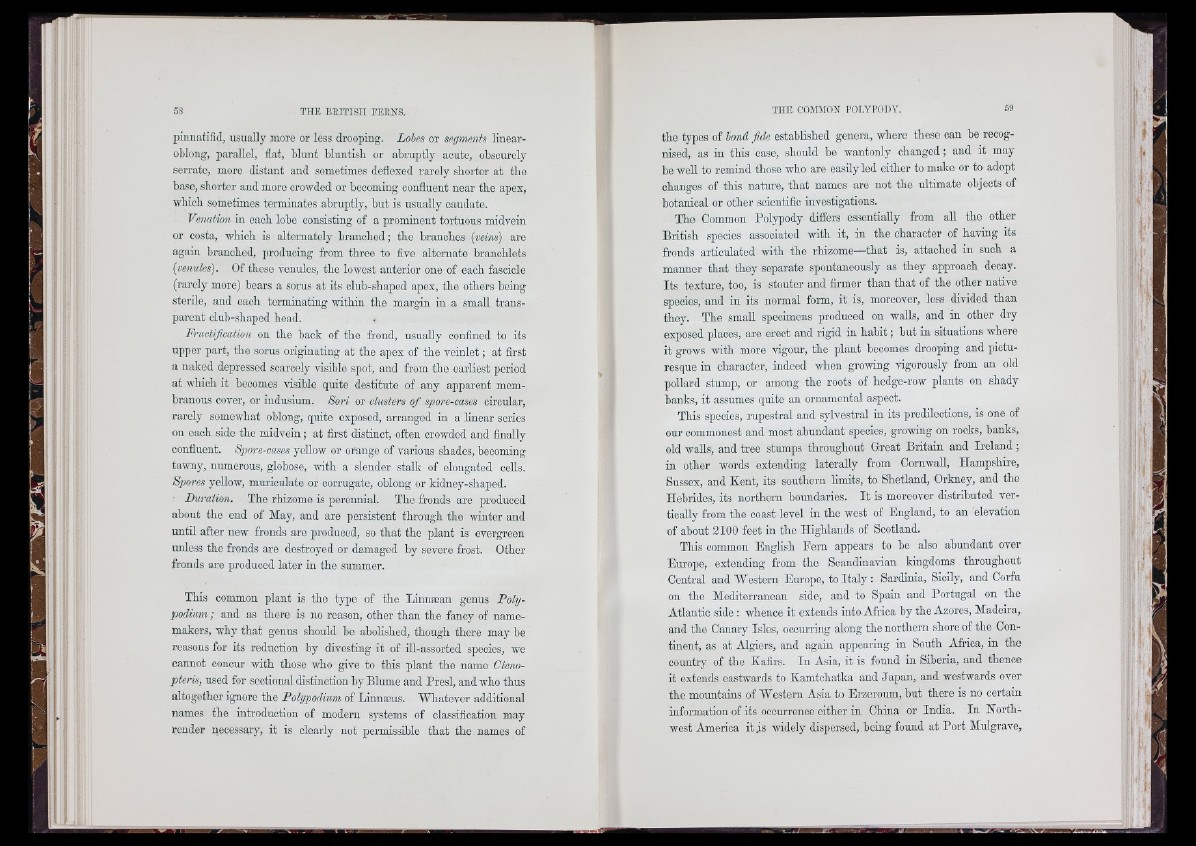
58 THE BRITISH EERNS.
pinnatifid, usually more or less drooping. Lobes or segments linear-
oblong, parallel, flat, blunt bluntisb or abruptly acute, obscurely
serrate, moro distant and sometimes doflexod rarely shorter at tho
base, shorter and moro crowded or becoming confluent near the apox,
which sometimes terminates abruptly, but is usually caudate.
Venation in each lobe consisting of a prominent tortuous midvein
or costa, which is alternately branched; tho branches {veins) aro
again branched, producing from throe to flve alternate branchlets
{venules). Of these venules, the lowest anterior one of each fascicle
(rarely more) bears a sorus at its club-shaped apox, the others being
sterile, and each terminating within the margin in a small transparent
club-shaped head.
Fnictification on the back of the frond, usually confined to its
upper part, the sorus originating at tho apex of the vcinlet ; at first
a naked depressed scarcely visible spot, and from the earliest period
at which it becomes visible quite destitute of any apparent membranous
cover, or indusium. Sori or clusters of spore-cases circular,
rarely somewhat oblong, quite exposed, ai’ranged in a linear series
on each side tho midvein ; at first distinct, often crowded and finally
confluent. Spore-cases yellow or orange of various shades, becoming
taTOy, numerous, globose, with a slender stallc of elongated cells.
Spores yellow, muriculate or corrugate, oblong or kidney-shaped.
Duration. The rhizome is perennial. The fronds are produced
about the end of May, and are persistent through the winter and
until after new fronds are produced, so th a t the plant is evergreen
unless tho fronds are destroyed or damaged by severe frost. Other
fronds are produced later in the summer.
This common plant is the type of the Linnæan genus Poly-
podiiim ; and as there is no reason, other than the fancy of name-
makers, why that genus should bo abolished, though there may be
reasons for its reduction by divesting it of ill-assorted species, we
cannot concur with those who give to this plant the name Ctono-
pteris, used for sectional distinction hy Blume and Prosl, and who thus
altogether ignore the Polypodium of Linnæus. Whatever additional
names the introduction of modern systems of classification may
render necessary, it is clearly not permissible that the names of
THE COMMON POLYPOHY. 59
the types of bond fide established genera, where these can he recognised,
as in this case, should bo wantonly changed ; and it may
bo woU to remind thoso who aro easily led either to make or to adopt
changes of this nature, that names aro not the ultimate objects of
botanical or other scientific investigations.
The Common Polypody differs essentially from aU the other
British species associated with it, in the oharaoter of having its
fronds articulated with the rhizome—that is, attached in such a
manner that they separate spontaneously as they approach decay.
Its texture, too, is stouter and firmer than that of the other native
species, and in its normal form, it is, moreover, less divided than
they. Tho small specimens produced on walls, and in other dry
exposed places, are erect and rigid in h a b it; but in situations wbero
it grows with more vigour, the plant becomes drooping and picturesque
in character, indeed when growing vigorously from an old
pollard stump, or among tho roots of hedge-row plants on shady
banks, it assumes quite an ornamental aspect.
This species, rupcstral and sylvestral in its predilections, is one of
our commonest and most abundant species, growing on rooks, banks,
old walls, and tree stumps throughout Great Britain and Ireland ;
in other words extending laterally from Cornwall, Hampshire,
Sussex, and Kent, its southern limits, to Shetland, Orlmey, and the
Hebrides, its northern boundaries. I t is moreover distributed vertically
from the coast level in the west of England, to an elevation
of about 2100 feet in the Highlands of Scotland.
This common English Fern appears to be also abundant over
Europe, extending from the Scandinavian kingdoms throughout
Central and Western Europe, to Italy : Sardinia, Sicily, and Corfu
on the Mediterranean side, and to Spain and Portugal on the
Atlantic side: whence it extends into Africa by tbe Azores, Madeira,
and tbe Canary Isles, occurring along the northern shore of the Continent,
as at Algiers, and again appearing in South Africa, in the
country of the Kafirs. In Asia, it is found in Siberia, and thence
it extends eastwards to Kamtchatka and Japan, and westwards over
the mountains of W estern Asia to Erzeroum, but there is no certain
information of its occurrence either in China or India. In Northwest
America it is widely dispersed, being found at Port Mulgrave,
.'"I